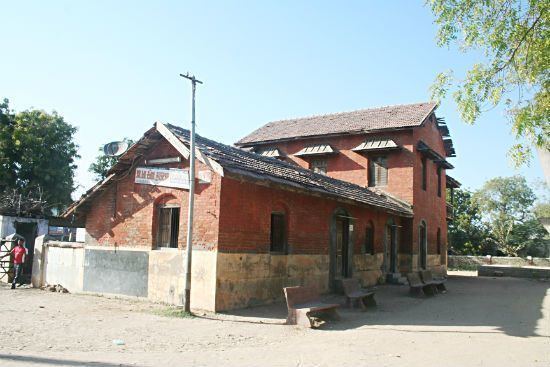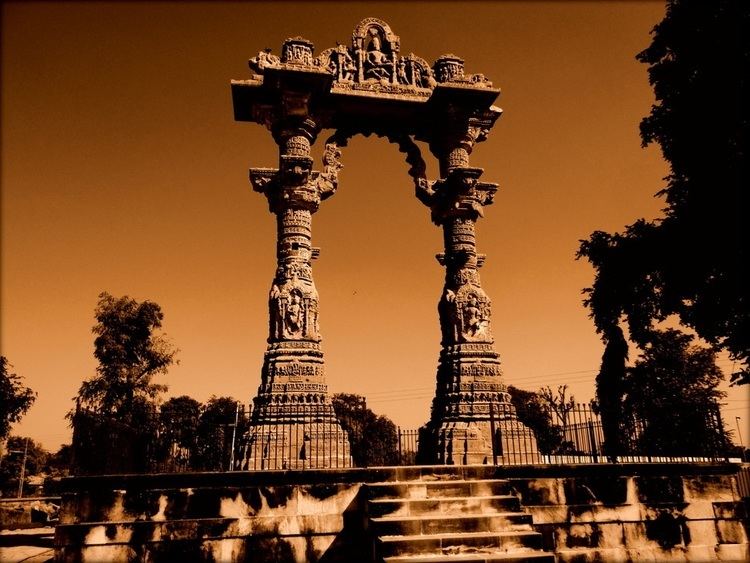Country State | Languages spoken District | |
 | ||
Map of Vadnagar
Vadnagar (Gujarati: વડનગર) is a city and a municipality in Mehsana district in the Indian state of Gujarat. It is the birthplace of Narendra Modi, the 14th and current Prime Minister of India.
Contents
- Map of Vadnagar
- Baby modi played with small crocodiles in vadnagar
- Geography
- Demographics
- History
- Places of interest
- Schools
- Colleges
- References

Baby modi played with small crocodiles in vadnagar
Geography
Vadnagar is located at 23.78°N 72.63°E / 23.78; 72.63. It has an average elevation of 143 metres (469 feet).
Vadnagar is located south of Kheralu Taluka. To the West Unjha telgah, South- Visnagar and Vijapur telgah and on East side Sabarkantha Districts are located.
Demographics
As of 2001 India census, Vadnagar had a population of 25,041. Males constitute 51% of the population and females 49%. Vadnagar has an average literacy rate of 65%, higher than the national average of 59.5%: male literacy is 75%, and female literacy is 54%. In Vadnagar, 13% of the population is under 6 years of age.
History
Several ancient inscriptions and literary sources mention a town called Anartapura or Anandapura, which is identified as the area in and around the present-day Vadnagar. The Mahabharata mentions the Anarta Kingdom in the norther part of the present-day Gujarat. The oldest Puranic legend about Gujarat is about a king named Anartha. The Junagadh rock inscription (150 CE) of Western Kshatrapa king Rudradaman I mentions a region called "Anartha" (meaningless) in the northern part of the present-day Gujarat. The Maitraka rulers of Vallabhi (505-648 CE) issued several land grants to the Brahmins of Anarthapura or Anandapura. The last mentions of Anarthapura appear in 7th century, when the Chinese traveler Xuanzang recorded his visit to O-Nan-To-Pu-Lo (Chinese form of "Anandapura"). The Harsola copper plates (949 CE) of the Paramara king record the grant of two villages in Gujarat area to the Nagar Brahmins originating from Anandapura. This Anandapura is also identified with Vadnagar, which is associated with the Nagar Brahmins. In 2009, the archaeologists discovered a 4 km long fortification near Vadnagar, which they believe could be the historical Anartapura.
Vadnagar has also yielded an image of Bodhisattva dated back to the 3rd or 4th century AD. This image seems to be brought from Mathura to install in one of the Buddhist monasteries of the town.
It is also said that Vadnagar was the earliest capital of Gujarat. Vadnagar's old town is located inside the walls of a fort which has six gates namely Arjun Bari, Nadiol, Amarthol, Ghaskol, Pithori and Amarthol in which Amarthol gate area is the oldest existing part of the town. The river Kapila used to flow through the town of Vadnagar
Places of interest
The town is also blessed with a magnificent lake named as "Sharmistha Lake" which has a small island like place amidst it. It is connected with a 7 km long inlet canal. The government is developing this island into a beautiful garden.
Vadnagar also has various public architectures like a Museum and Library, government hospital and a government court.
There are scores of temples dedicated to almost every God: Shiva (Daaneshwar Mahadev Temple, Somnath Mahadev Temple and ancient Kashi Vishveshvara temple), Vishnupuri, Chhabila, Hanuman, Ashapuri Mata, Ambaji Mata, Sitla mata, Bhuvaneshpuri Temple, Amther Mata, Gauri kund, Swaminarayan Temple, two Jain derasars, to name just a few.
Of the numerous Shiva shrines, the 15th-century "Hatkeshver Mahadev" is the most important. He is the family deity of the Nagar Brahmins. Facing the east, it is enclosed by a high wall surmounted by three circular domes. From the roof of the sanctum rises a massive pinnacle, which soars high above in the sky. A massive congregation hall leads to the sanctum which houses a shivling said to have self-emerged or as it is said -"Swayambhu"(self emerged). The exterior of the temple is exquisitely and profusely ornamented with figures of the nine planets, regent deities, the chief gods of the Hindu pantheon, scenes from the life of Krishna and Pandava princes, besides the varied animal and floral motifs.
Renovated twice or thrice is the "Sitla Mata" Temple ornately carved with figures of celestial beings. Its door frames and ceilings depict the Rasmandala (Krishna dancing with milkmaids). The most striking pieces of architecture in Vadnagar, however, are the two magnificent Kirtistambhas or triumphal arches. Built of red sandstone they are both identical in size and style. Only, one lies in pieces on the ground (now re-erected) and the other stand erect. Its pillars and arches are decorated with lozenges at the base and geometric and floral designs-leaves, creepers, lotus, animal motifs, human figures engaged in various activities and divine figures in different poses. The top bears an image of a seated god Kartikeya flanked by Ganesh and Makara (griffin) from which spring arches. A number of standing female figures also ornament the top. Vadnagar is also known as Skandhpur after Kartikeya, who is identified with Murugan.
